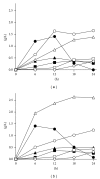The probiotic Bifidobacterium breve B632 inhibited the growth of Enterobacteriaceae within colicky infant microbiota cultures
- PMID: 25309908
- PMCID: PMC4163384
- DOI: 10.1155/2014/301053
The probiotic Bifidobacterium breve B632 inhibited the growth of Enterobacteriaceae within colicky infant microbiota cultures
Abstract
Infant colic is a common gastrointestinal disorder of newborns, mostly related to imbalances in the composition of gut microbiota and particularly to the presence of gas-producing coliforms and to lower levels of Bifidobacteria and Lactobacilli. Probiotics could help to contain this disturbance, with formulations consisting of Lactobacillus strains being the most utilized. In this work, the probiotic strain Bifidobacterium breve B632 that was specifically selected for its ability to inhibit gas-producing coliforms, was challenged against the Enterobacteriaceae within continuous cultures of microbiota from a 2-month-old colicky infant. As confirmed by RAPD-PCR fingerprinting, B. breve B632 persisted in probiotic-supplemented microbiota cultures, accounting for the 64% of Bifidobacteria at the steady state. The probiotic succeeded in inhibiting coliforms, since FISH and qPCR revealed that the amount of Enterobacteriaceae after 18 h of cultivation was 0.42 and 0.44 magnitude orders lower (P < 0.05) in probiotic-supplemented microbiota cultures than in the control ones. These results support the possibility to move to another level of study, that is, the administration of B. breve B632 to a cohort of colicky newborns, in order to observe the behavior of this strain in vivo and to validate its effect in colic treatment.
Figures

 ), Bifidobacterium (⚪), and Enterobacteriaceae (■) were quantified by FISH in control cultures (MC, (a)) and in cultures supplemented with B. breve B632 (PMC, (b)). Data are means ± SD, n = 4.
), Bifidobacterium (⚪), and Enterobacteriaceae (■) were quantified by FISH in control cultures (MC, (a)) and in cultures supplemented with B. breve B632 (PMC, (b)). Data are means ± SD, n = 4.
 ) and Enterobacteriaceae (⚪) were quantified by qPCR in control cultures (MC, dashed line) and in cultures supplemented with B. breve B632 (PMC, solid line). Data are means ± SD, n = 4. Stars indicate statistically significant difference between MC and PMC cultures (P < 0.05).
) and Enterobacteriaceae (⚪) were quantified by qPCR in control cultures (MC, dashed line) and in cultures supplemented with B. breve B632 (PMC, solid line). Data are means ± SD, n = 4. Stars indicate statistically significant difference between MC and PMC cultures (P < 0.05).
 ), acetate (△), formate (▲), propionate (□), 2,3-butanediol (■), and butyrate (22C4) were determined in control cultures (MC, (a)) and in cultures supplemented with B. breve B632 (PMC, (b)). Data are means, n = 4, and SD always < 0.25 g/L.
), acetate (△), formate (▲), propionate (□), 2,3-butanediol (■), and butyrate (22C4) were determined in control cultures (MC, (a)) and in cultures supplemented with B. breve B632 (PMC, (b)). Data are means, n = 4, and SD always < 0.25 g/L.References
-
- Morelli L. Postnatal development of intestinal microflora as influenced by infant nutrition. Journal of Nutrition. 2008;138(9):1791S–1795S. - PubMed
-
- Guarner F, Malagelada JR. Gut flora in health and disease. The Lancet. 2003;361(9356):512–519. - PubMed
-
- Sekirov I, Russell SL, Caetano M Antunes L, Finlay BB. Gut microbiota in health and disease. Physiological Reviews. 2010;90(3):859–904. - PubMed
-
- di Gioia D, Aloisio I, Mazzola G, Biavati B. Bifidobacteria: their impact on gut microbiota composition and their applications as probiotics in infants. Applied Microbiology and Biotechnology. 2014;98(2):563–577. - PubMed
MeSH terms
LinkOut - more resources
Full Text Sources
Other Literature Sources
Research Materials

